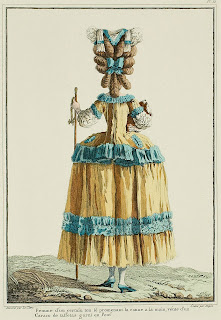Late Georgian Hairstyles: Fewer Buns Than You'd Think
It looks like I made a Twitter thread on this back in February of 2020, and while I always intended to turn it into a blog post, I suppose it's not surprising that I, er, forgot about it.
But I've been thinking about the basic late Georgian hairstyle for a long time, ever since a long-ago Facebook thread on the subject. Most people were of the opinion that a bun would have been the default, but I'd been translating my fashion plates for quite a while by that point, and had noticed that the fashionable 1770s-1780s styles never incorporated a bun. Instead, they were mostly a mass of curls, and the part of the hair that was longer was simply pulled up the back of the head (sometimes braided, sometimes not) into what was referred to as a chignon.
Obviously these hairstyles are exaggerated for the purpose of showing their details to the subscribers who wanted to imitate them, and then on top of that, these prints are aimed at an elite audience and don't remotely represent the average woman. But much of fashion in this period was less about specific styles limited to the wealthy (polonaise aside) and more about taking a common method of making and then doing it in the best materials or with the most elaborate trimming if you could afford it. The plates in Costumes Françaises are an excellent illustration of this. Gowns were constructed in a particular way throughout most of the eighteenth century, regardless of income level and class, for instance. So it seemed most likely to me that hair would also be styled in the same basic ways, but with only the leisured able to afford hairdressers to create elaborate confections of powdered curls or to deal with thick chignons.
We can get a decent idea of what this might have looked like for less-fashionable women by looking at the more restrained, practical styles of earlier decades.
| "Mme de Pompadour", Jean-Baptiste Pigelle, ca. 1750; MMA 49.7.70 |
This sculptural bust of Jeanne Poisson, Marquise de Pompadour, for instance, has some simple curls framing the face and then a braided triple chignon to manage the less-important hair that would usually be covered by a cap. (Click through to the museum website to see photos of the piece from all angles except directly above, which is understandable from an artistic perspective but irritating from a fashion historian's! I cannot make out how the ends of the braids are treated.)
And what makes this theory so compelling to me is that there is plenty of evidence of the same method of controlling the hair being used later in the period, in what we usually call the Regency!
I first noticed this in Boilly's L'Entrée au Jardin Turc (1812), which I'd made the background of my work computer. As I had two monitors, the image was spread out and magnified.
 |
| Getty 2010.11 |
This is a street scene, containing figures who were supposed to be recognizable to the contemporary viewer as ordinary. And all of women in it whose hairstyles can be fully made out have chignons held up with combs.
Here are some other pieces of artwork that clearly show the same kind of hairstyle:
"Two Women," Eunice Griswold Pinney, ca. 1800; FAM N0077.1961
"Portrait of a Woman," Adam Buck, 1804; MMA 95.14.81
"Elisa Baciocchi," Giovanni Antonio Santarelli, ca. 1809; MMA 38.145.37
"Ann Buchan Robinson," Pierre Jean David D'angers, 1831; MMA L.2016.8a,b
Combs were very common in the period, often made very simply out of horn or tortoiseshell. Seeing them used this way made me reinterpret many portraits I've seen that have appeared (working on the assumption that the bun was the default historical hairstyle) to be buns held in place with combs: they are more likely to be braids, or simply unbraided tresses, folded up on the back of the held and pinned with combs.
| Tortoiseshell comb, ca. 1810; MMA 43.152.5 |
As an additional point I'd bring in is this description from Charles Dickens's Our Mutual Friend (first published 1864-1865):
Pleasant Riderhood shared with most of the lady inhabitants of the Hole, the peculiarity that her hair was a ragged knot, constantly coming down behind, and that she never could enter upon any undertaking without first twisting it into place. At that particular moment, being newly come to the threshold to take a look out of doors, she was winding herself up with both hands after this fashion. And so prevalent was the fashion, that on the occasion of a fight or other disturbance in the Hole, the ladies would be seen flocking from all quarters universally twisting their back-hair as they came along, and many of them, in the hurry of the moment, carrying their back-combs in their mouths.
Buns did exist in the Regency, of course. In the French fashion press, they're sometimes referred to as choux, "cabbages" (if worn low and large), or as coiffures à la Chinoise (if worn high on the head). But they were an option, not the default.







Comments
Post a Comment